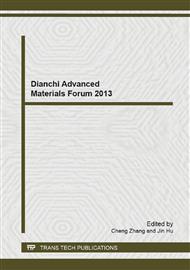p.154
p.159
p.165
p.169
p.173
p.177
p.181
p.185
p.189
Influence of different Thickness of Zirconia Core on the Flexural Strength in Article Saliva
Abstract:
To Study the Effect of Different Core Thickness on the Flexural Strength of Zirconia and Feldspathic Ceramics. Bilayered Zirconia-Feldspathic Samples of Three Commercial Brands were Made in Three Different Thickness(n=10): 0.5 Mm, 0.8 Mm and 1.0 Mm Respectively. on Zirconia Core Specimens of each Thickness, Feldspathic Dentin Porcelain was Added to Reach a Total Crown Thickness of 2 Mm. Samples were Stored in Artificial Saliva with Neutral Ph for 10 Days at 37°C. Flexural Strength was Conducted with 3-Point Bending Test. Data were Analyzed by One-way ANOVA, and Multiple Comparisons were Performed Using Student-Newman-Keuls Test(α=0.05). the Measurement of 1.0 Mm Group was Higher than the other Groups, and 0.5 Mm Group was the Lowest(P<0.05), Regardless of any Commercial Brand. Commercial Dental Zirconia Blocks had Varied Flexural Strength, Zirkonzahn Expressed Highest Value in any Thickness Group Compared with the other Materials. Moreover, the Fracture Mode of Zirconia Bilayered Composites was Different in this Study, 0.5 Mm and 0.8 Mm Groups Exhibited Higher Number of Fragments and Appeared to Delamination Compared with 1.0 Mm Group. so we Infer that the Thickness of Core can have an Effect on the Flexural Strength of Bilayered Zirconia-Feldspathic Crown, as well as Different Kinds of Materials.
Info:
Periodical:
Pages:
173-176
Citation:
Online since:
November 2013
Keywords:
Price:
Сopyright:
© 2014 Trans Tech Publications Ltd. All Rights Reserved
Share:
Citation:


